How to Get Started in Racial Equity Work: Plant a Justice T.R.E.E.E.
BY TIFFANY GALVIN GREEN, PH.D., AND MEGAN WILSON-REITZ | July 30, 2020
“I want to help promote racial equity… but where do I start?”
Over the past few months, Diversity, Equity, and Inclusion (DEI) professionals everywhere have been working quickly to try to answer this question, in conversations seeded by our friends and colleagues who are alert to the national conversation about racial justice happening in our streets, on our television screens, in our family meals, and at our conference tables. Everywhere we look, we see new actions sprouting—conversations and dialogues, protests and demands, pledges and promises, statements. But in the middle of so much new growth around us, where do we plant ourselves?
For those of us whose daily lived experience includes a constant struggle against inequities, hatred, and other barriers because of our race, the desire to take action to protect ourselves and others is a commitment forged in persistence and tinged with weariness. For others of us, the brutality of racism and injustice has been observed with dawning horror, rather than directly experienced. For all of us, however, this historical moment has served as a moment to spur us to action. There is a sense of hope that our society can and must grow into something better—but what’s the best way to proceed? Which of these many sprouts should we water? Those who ask the question genuinely want to get involved, but they aren’t sure how or where to begin.
This is where we have found ourselves most recently, as we have been asked to engage with people across our university community who are asking for guidance about how to make (or deepen) their own commitment to cultivating the work of racial equity. In response to this need, we have developed an organic framework for answering the question “How do I get started in racial equity work?” We call it the “Justice T.R.E.E.E.” (Tackling Racism: Educate, Engage, and Effect Change).
The limitations of linear models of individual anti-racist development
There is an abundance of resources available right now addressing issues of racism. The most effective of these tend to encourage the idea that “not racist” is no longer enough. In order to avoid upholding racist ideologies, practices, and systems, they argue, a person must be actively “anti-racist.” This is an important distinction: it is not enough to have the “correct” beliefs or ideas about race; what is needed is an active commitment to work for justice. Thus there is no such thing as “not racist”—one is either supporting racism or actively engaged in dismantling it.
In principle, this idea is correct. Commitment to justice does indeed require more than a simple belief in the truth of equality. However, in many of the frameworks for anti-racist work, the focus is on an individual’s linear progress from a state of ignorance to “wokeness.” The implication in these models is that once achieved, “wokeness” is a permanent state of being, just like the label “not racist.”
An Ignatian paradigm for ecological, systemic racial justice work
We offer the Justice T.R.E.E.E. Model for anti-racism, therefore, as a corrective to the more mechanistic models that treat anti-racism as a linear individual path, carefully engineered to arrive at the end goal of “personally anti-racist.” The Justice T.R.E.E.E. addresses racial justice, instead, as a complex, perpetually evolving process of constant growth. We conceive of the work of anti-racism, not as a linear road map to a destination, but rather, as an organic and systemic process of community growth. In our model, the individual grows by increasingly subsuming the self into a network of interconnected organisms at multiple levels, learning to contribute to the growth of the whole, and depending on the whole to grow as well.
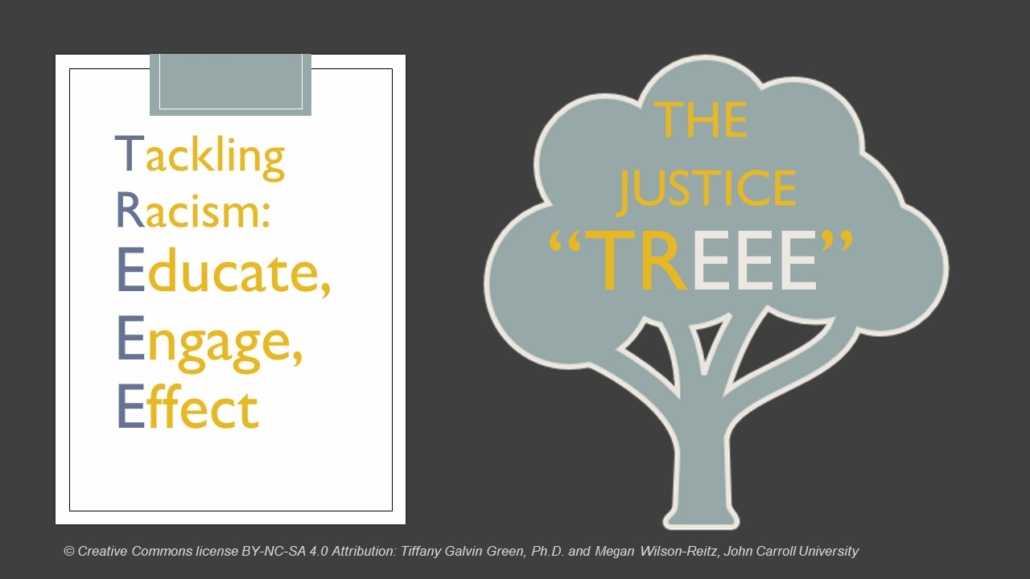
For those who, like us, do this work within Jesuit institutions, it can also be instructive to notice how closely this cyclical model aligns with the Ignatian pedagogical framework. It is a model of learning, growing, bearing fruit, planting, followed by learning and growing again, akin to the paradigm that informs all Jesuit education.
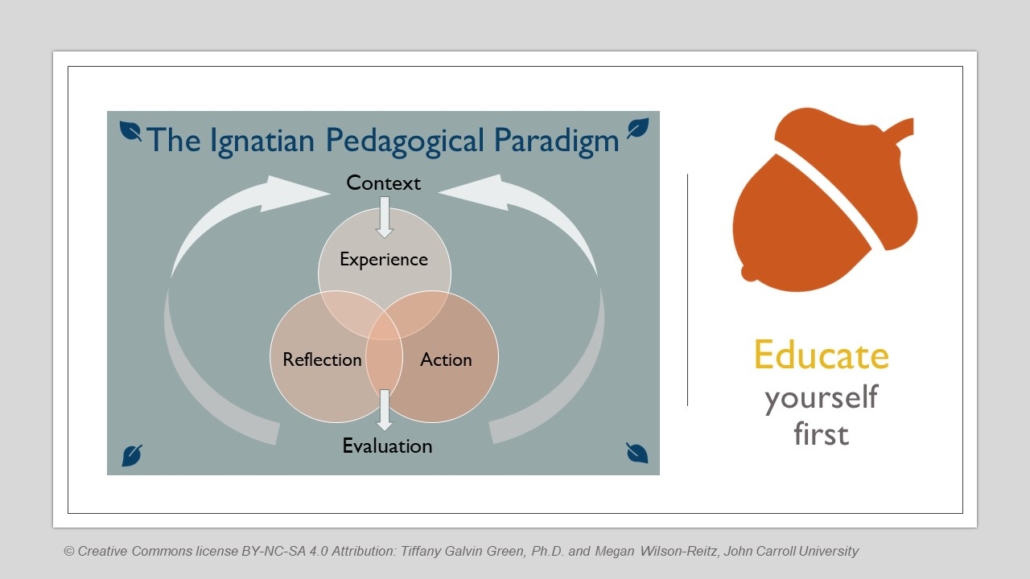
Unlike “banking” models of education, where the job of the learner is to receive information passively and store it up until they are “full,” the Ignatian model imagines education as a dynamic and cyclical process whereby one first absorbs information in order to give context to a concrete experience, then reflects on that experience in order to take action. Then one evaluates that action before identifying where next to seek out context, which will be used to inform the next cycle of experiences, reflection, and action. The Justice T.R.E.E.E. model, likewise, identifies anti-racist education as a process where we continually cycle through new layers of growth, often returning to square one when we encounter new information or have to process new experiences.
The Justice T.R.E.E.E., “Tackling Racism” through its 3 E’s (Educate, Engage, and Effect), uses the analogy of the life stage progression of a seed to a tree to a forest. This image, we believe, captures the cyclical, constant, and evolving nature of racial justice work.
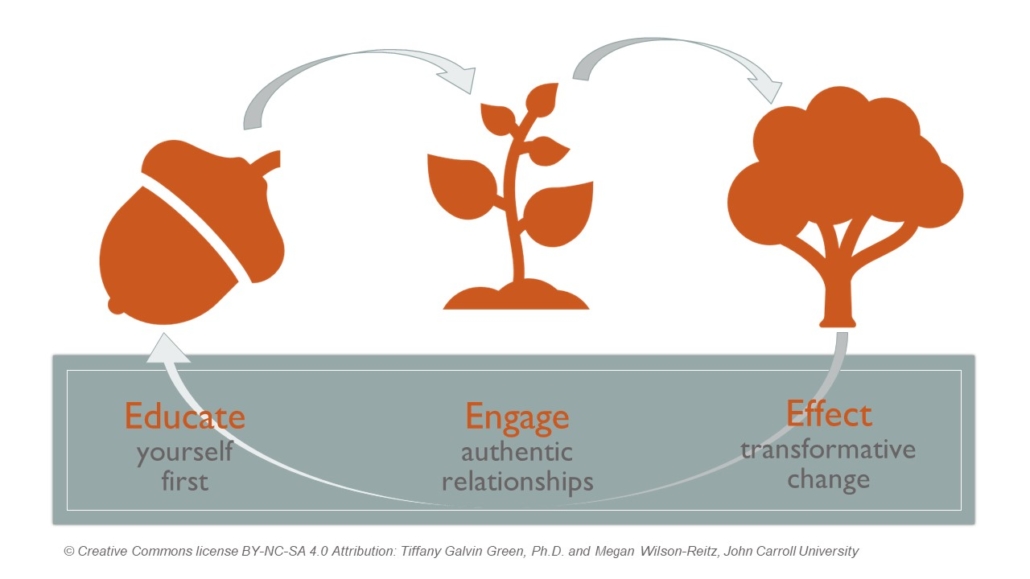
This model adopts a series of images for justice work based on the life cycle of an oak tree:
- The acorn, in its hard shell, may appear to be doing little, when in fact, it is working hard to soak up the nutrients needed to push through its shell and begin putting down roots. In this nascent, insular stage, a person is beginning to shore up their knowledge, drawing in new information and ideas from outside the system that encloses and imprisons us, seeking education in order to gain power to burst through its constraints and seek new growth.
- The sapling, in its fragile, reaching state, is wholly dependent upon the elements in its environment for survival: water, sunlight, air, soil. The sapling stage, in anti-racist work, is the process of engaging in difficult conversations, mishaps, and dialogues as a means of gaining strength and building relationships.
- Finally, the tree stage is a position of strength. Rooted firmly in its own context, the tree can effect change in its environment, providing shelter, shade, and roots for others to grow. In the tree phase, one draws deeply upon the nutrients of the supportive system for sustenance, while also adding to the greater ecosystem. Finally, in its mature stage, a tree is always dropping acorns, restarting the cycle in new ways for one’s own growth and for the growth of others.
How this model can help shape our narratives
The Justice T.R.E.E.E. approach is one that can capture the complexities of individual (and communal) learning and growing in racial equity work. For example:
- Just as a tree cannot mature in one night’s growth, neither is a burst of enthusiasm sufficient for a person to contribute meaningfully to the work of racial justice. This is a common problem, which leads to incredible frustration when a person attempts to engage without understanding, play “lone ranger,” or try to “save” others without understanding the full history or interconnectedness of the struggle.
- Just as a tree cannot spring fully formed from its seed without external supports like light, air, soil, and sunshine, neither can a person engage meaningfully in the work through personal efforts alone. Some rely solely upon a personal journey of self-education, such as reading, to prepare them for community work. However, the sapling stage is essential to be effective. Exposure to the environment—its people, its rhythms, its expectations, its values—is needed while growing and learning.
- Just as a tree’s growth does not end when it reaches maturity, the development of an individual in the work of racial justice is never complete. The mature tree continues to add rings as it absorbs more nutrients, moving outward into the world, taking up more space as it puts down deeper roots in its environment. Likewise, a person who wants to make meaningful change for racial justice must continually deepen their connections to their community, expand their engagement with their surroundings, continue to absorb the knowledge that helps it to keep growing, and provide the seed, shade, and structure to nurture the growth of others who come after them.
In the end, after all, the goal is not to produce one healthy tree. The goal is to grow a healthy forest.
Growing a Healthy Ecosystem: Pursuing the Three “E’s”
There is much to be said about each of the E’s in the T.R.E.E.E. model—Educate, Engage, and Effect. Here are a few of the most crucial points to remember at each stage:
Educate Yourself First (Acorn)
- Approach what you learn, read, listen to and watch with a growth mindset. No one can grow unless they are open to becoming better, recognizing that there is always more to learn. As explained by NYU Professor Dolly Chugh, we have to be willing to let go of our sense of self that clings to being “a good person” in order to have the freedom to become a better person.
- Understand that colorblindness is not the right lens for attaining justice. You cannot see racism if you do not see color. Colorblindness also means that you are blinding yourself to the many forms of racism and discrimination that exist in our society and its structures. Colorblindness, thus, stifles the ability to truly see the lived experiences of the other.
- Lived experience is important, but lived experience is not the same as education. Centering the lived experience and voices of people of color is of central importance in this work, and yet, those experiences may vary as widely as the individuals who describe them. This work requires, therefore, self-reflection and self-education, examining one’s own lived experiences (and others’) through the lens of history, policies, practices, institutions, and data, or identifying the patterns and systems at work in the larger picture.
- Take responsibility for your own education. Do your research on issues that you are not familiar with. Be careful not to assume that it is up to other people to educate you; this work is your responsibility. When other people do help you on your journey to self-education, whether through their own work or writing, or as generous friends, give them loud and enthusiastic appreciation, and credit. (And money for their labor, where appropriate.)
- Recognize that just because you are new to the conversation, it doesn’t mean that it’s a new conversation. For those that are entering into this work for the first time, the range of education is likely much broader and longer than you realize. You are learning about legacies as much as you are learning about current debates and controversies.
Engage Authentic Relationships (Sapling)
- When engaging on difficult issues, listen more than you speak. This is particularly important for those who are accustomed to having their voices centered. Choose to step out of the center of the conversation; consider the likelihood that racism, rather than merit, placed you there to begin with. Listen to the arguments being made by others. Listen to understand first, not to respond. Listen with curiosity. Listen to identify the sources of conflict or misunderstanding.
- Be purposeful in conversation. Understand what your goal is and remain conscious of how you position yourself in conversations. Stay present, recognize your emotions, and embrace the discomfort as an opportunity for learning.
- Know when it’s time to call someone out and when it’s time to call someone in. When you observe problem behavior from others (such as racist speech or actions), it is important to know when to call it out—making it clear that the behavior is unacceptable and will not be tolerated—versus calling it in, seizing the opportunity to explore the issue more deeply, make meaning together, and seek mutual understanding across difference.
- Get out of your own way. Defensiveness is an obstacle to your own growth. Notice your defensiveness (and that of your conversation partner) rather than letting it speak for you.
- Ask and allow for grace when mistakes happen. When starting on the path of interpersonal engagement on these difficult issues, we all mess up somewhere. “Oops” and “ouch” moments will happen. When the inevitable happens, apologize and/or forgive, and don’t let the “ouch” keep you from continuing to do the work.
- Don’t be a trophy seeker. We don’t get rewards for showing up for the work of justice. No one hovers over each acorn to celebrate the moment it decides to crack open. It is the job of a sapling to grow into a tree, and the forest requires it. Our work for justice is not a gift we are giving to others, but it is our work of growing into better selves.
Effect Transformational Change (Tree)
- Find your unique place in the ecosystem. A forest is characterized by the many interconnected species that create a system in balance. The work of Deepa Iyer provides an instructive model for helping us understand our own particular roles in the work of social change. In our lives and as part of movements and organizations, we play many different roles in pursuit of equity, shared liberation, inclusion, and justice.
- Leverage your power, privilege, and access. A strong tree can provide shelter and shade for many others. Recognize your personal sources of power—where and with whom you have influence; your expertise and talents; your position in institutions; privileges granted by your social identities. Interrogate the systems that you have direct influence over and participate in, from the church council to the PTA to the nonprofit board on which you sit. Assessing all of these areas helps you to better understand your role in the ecosystem, as well as how you can effectively act in those systems in ways that consistently amplify, center, and support those with less power, privilege, or access.
- Be an advocate and a “racial equity broker,” as discussed by Professor Rashawn Ray, at University of Maryland-College Park. This requires moving beyond being passive or minimally supportive, to speaking up and speaking often about injustices that you witness. It also means finding the means to broker your voice into real policy changes.
- Move from being an “ally” to becoming an “accomplice.” An ally will mostly engage in activism by standing with an individual or group in a marginalized community. An accomplice will focus more on dismantling the structures that oppress that individual or group—and such work will be directed by the stakeholders in the marginalized group. See another perspective given by Teaching Tolerance.
- Practice good followership. Good followership is characterized by active participation in the pursuit of larger goals. In many cases, this means working independently, being accountable for your actions, and taking ownership of necessary tasks. It also means supporting those who are leading the charge without having to ‘take over’ or be ‘centered’ in decision making or actions.
- Pay attention to who is “at the table” and “in the room.” In the systems where you have influence, where you become involved in discussions, decisions, and problem solving, ensure that there is representation in the process. When there are voices missing at the table, follow the four steps of making space:1) Listen harder to identify the voices/perspectives that aren’t being heard;
2) Amplify these voices (using your own power, privilege, and access);
3) Invite those whose views/voices aren’t in the discussion to the table; and,
4) “Pass the mic” so that they can speak for themselves.
In sum, while this model is deliberately simple, we hope that it serves as a clear framework for helping individuals move towards action for racial justice, in a pattern that follows the natural cycles of seed to sapling to tree.
Most importantly: remember that the job of a tree is not done when it reaches maturity. The growth of trees continues indefinitely, reaching ever higher, broader and deeper, as does ours. In addition, the mature tree also has another important job: to bear fruit, and to generate more seeds, thereby restarting the process with another cycle, to inspire a richer, healthier social ecosystem where all living beings can thrive. It is this work to which we should all be called in order to create a more equitable society.
Tiffany Galvin Green, Ph.D. serves as Vice President for Diversity, Equity, and Inclusion at John Carroll University, where she oversees all matters of equity, inclusiveness, diversity, equal access, and the prevention of discrimination and harassment. Previously, Dr. Green served as Assistant Vice Provost for Inclusive Excellence at Vanderbilt University. She also has industry experience having been the CEO and executive director of River Region Human Services, Inc. in Jacksonville, Florida, where she oversaw 13 non-profit locations and 200+ employees across three counties. Previous faculty appointments include the Isenberg School of Management at the University of Massachusetts, Capella University (Minnesota), Flagler College (Florida), the University of Utah, University of Texas at Dallas, and the Kellogg School of Management at Northwestern University. Dr. Green holds a Ph.D. in organizational behavior and M.S. in management/organizational behavior from Northwestern University and a B.B.A. from the University of Michigan.



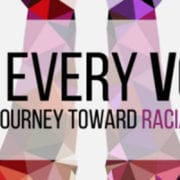
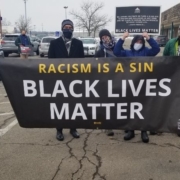

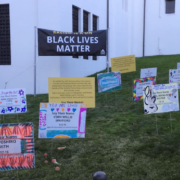


This is probably one of the better written works up to date I have read on the site, very well thought out and put together nicely and it just shows that something can be written without the need to target one specific race and still make some valid points and maybe other contributions on the site can learn from this, but there is a couple of issues. Has a person that donates heavily to fight racial issues and in educational facilities I’m deeply concerned regarding the ecosystem paragraph, there is a hint of stereotyping if you take the colorblindness and people of color voices are of central importance prior and read this paragraph and after a few parts towards the end. In other words those white privilege people that have either the platform, money or power in certain establishments just agree with everything and it all be good and let us get on with it and say bad things about the race which is according to certain outlets oppressing us while we gladly take the free money and resources and the cycle continues. You are a Vice President for diversity and I feel that you cannot fill that role without been biased has some points seem to favor certain races, has of today I will be freezing funding in my involvement of some racial injustice programs and I will be advising others to follow suit until I’m happy that real colorblindness is not a problem at any of the places I put money in to help the future generation. Thank you for opening my white eyes God Bless all lives that exist in this world.
I just want to thank you for opening my eyes, myself and fellow contributors that put our wealth in to education programs, has of today we have completely removed funding at the moment to 27 facilities in 11 states after discovering racism and pro activism and in most cases we found that 72% were openly promoting white hate literature, 8% Black hate, 10% Asian hate, 5% Hispanic and Latino and 5% other, there was misuse in funds and elements of marxism .We have given a 30 day appeal notice to those facilities.There was also a spike of hate crimes and a increase of black vs black racism which we do not tolerate also any form of racism this includes racism towards white people too, we may intend in the future to put our funds in to similar programs like the ones you promote but it is too one sided and defeats the objective of fighting racism and justice at this time whilst making false assumptions and placing a whole race in to one basket and labelling every person the same is racism and when you don’t agree it is privileged or racist, this is not defeating racism at all but is slightly contributing to it. God Bless
Brilliant piece of writing. Well done Tiffany Galvin Green. Life is a short journey, a pilgrimage. Ultimately all racists and anti-racists are racing in solidarity towards our final destination.
Ctrl-F “God”
0 results
Ctrl-F “Jesus”
0 results
Ctrl-F “Christ”
0 results
I praise god everyday for the blessings of Diversity, and the executive-level administrators that manage it! It’s such a blessing!
Your work colleagues have got your back nice to see healthy solidarity within the work place. All I have seen on here is about Black, Hispanic & Latino and white guilt ( nothing good about whites )…..How is that Diversity ? There are more races that need to be represented in written works ( not authors ) to make it feel more diverse and I stay with my previous comment regarding the author been biased in a position of trust. Myself and wealthy partners have invested over $350m in education programs alone and yes we are “Economically Privileged” not white privileged to do it and we have put roughly $140m in to the black community to help with poverty and community programs including gang prevention just this year. What have you done ? God Bless
Great Article! Thank you for sharing this very informative post, and looking forward to the latest one.